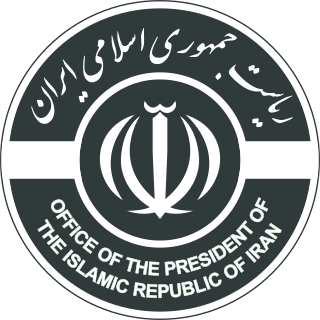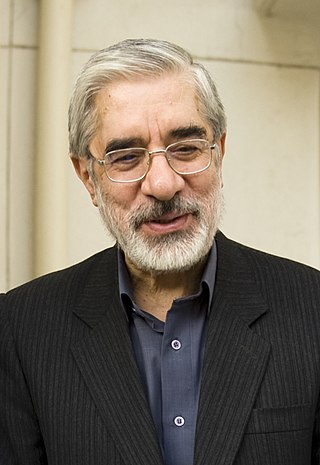| ||||||||||||||||||||
| Registered | 22,687,017 [1] | |||||||||||||||||||
|---|---|---|---|---|---|---|---|---|---|---|---|---|---|---|---|---|---|---|---|---|
| Turnout | 74.26% [1] ( | |||||||||||||||||||
| ||||||||||||||||||||
| ||||||||||||||||||||
Presidential elections were held in Iran on 2 October 1981 following the assassination of president Mohammad-Ali Rajai. Ali Khamenei was elected with 95% of the vote.
| ||||||||||||||||||||
| Registered | 22,687,017 [1] | |||||||||||||||||||
|---|---|---|---|---|---|---|---|---|---|---|---|---|---|---|---|---|---|---|---|---|
| Turnout | 74.26% [1] ( | |||||||||||||||||||
| ||||||||||||||||||||
| ||||||||||||||||||||
Presidential elections were held in Iran on 2 October 1981 following the assassination of president Mohammad-Ali Rajai. Ali Khamenei was elected with 95% of the vote.
Ali Akbar Parvaresh, Hassan Ghafourifard and Reza Zavare'i all publicly endorsed Khamenei for president, stating on television that they would vote for him. [2]
| October 1981 Iranian presidential election | |||||||
|---|---|---|---|---|---|---|---|
| Party | Candidate | Nohen et al [3] | ISSDP [1] | ||||
| Votes | % | Votes | % | ||||
| Islamic Republican Party | Ali Khamenei | 16,007,072 | 95.01 | 16,008,579 | 95.05 | ||
| Islamic Coalition Party | Ali Akbar Parvaresh | 341,841 | 2.03 | 341,874 | 2.02 | ||
| Islamic Republican Party | Hassan Ghafourifard | 75,658 | 0.45 | 80,545 | 0.48 | ||
| Islamic Republican Party | Reza Zavare'i | 62,156 | 0.37 | 59,058 | 0.35 | ||
| Blank or invalid votes | 360,269 | 2.14 | 357,661 | 2.12 | |||
| Totals | 16,846,996 | 100 | 16,847,717 | 100 | |||

The president of the Islamic Republic of Iran is the head of government of the Islamic Republic of Iran and the second highest-ranking official, after the supreme leader. The first election was held in 1980 and was won by Abulhassan Banisadr. Masoud Pezeshkian currently serves as the president of Iran, after being elected in the 2024 Iranian presidential election and being officially endorsed by the supreme leader.

Ali Hosseini Khamenei is an Iranian cleric and politician who has served as the second supreme leader of Iran since 1989. He previously served as the third president of Iran from 1981 to 1989. Khamenei's 35-year-long rule has made him the longest-serving head of state in the Middle East, as well as the second-longest-serving Iranian leader of the last century after Shah Mohammad Reza Pahlavi. Khamenei is a marja', a title given to the highest level of religious cleric in Twelver Shi'ism.

Ali Akbar Hashimi Bahramani Rafsanjani was an Iranian politician and writer who served as the fourth president of Iran from 1989 to 1997. One of the founding fathers of the Islamic Republic, Rafsanjani was the head of the Assembly of Experts from 2007 until 2011 when he decided not to nominate himself for the post. He was also the chairman of the Expediency Discernment Council.

Gholam-Ali Haddad-Adel is an Iranian conservative and principlist politician and former chairman of the Parliament. He is currently member of the Expediency Discernment Council.

The Assembly of Experts, also translated as the Assembly of Experts of the Leadership or as the Council of Experts, is the deliberative body empowered to appoint the Supreme Leader of Iran. All directly elected members must first be vetted by the Guardian Council.

Ali Ardeshir Larijani is an Iranian politician and former military officer in the Islamic Revolutionary Guard Corps, who served as the Speaker of the Parliament of Iran from 2008 to 2020. He has been a member of the Expediency Discernment Council since 2020, having previously served from 1997 to 2008. Larijani filed for candidacy in the 2024 presidential election, but was ultimately disqualified. He previously ran in 2005, but was disqualified from running in 2021.

Presidential elections were held in Iran 17 June 2005, with a second round run-off on 24 June. Mohammad Khatami, the outgoing president of Iran, stepped down on 2 August 2005, after serving his maximum two consecutive four-year terms according to the Islamic republic's constitution.

Mir-Hossein Mousavi Khameneh is an Iranian socialist politician, artist, architect and opposition figure who served as the 45th and last Prime Minister of Iran from 1981 to 1989. He was a reformist candidate for the 2009 presidential election and eventually the leader of the opposition in the post-election unrest. Mousavi served as the president of the Iranian Academy of Arts until 2009, when conservative authorities removed him. Although Mousavi had always considered himself a reformist and believed in promoting change within the 1979 constitution, on 3 February 2023, in response to the Mahsa Amini protests, he announced his opposition to the Islamic Republic and asked for a widespread referendum to fully change the constitution and make a fundamental change in Iran's political system.

The interim government of the Islamic Republic of Iran was established after the assassination of Mohammad-Ali Rajai (President) and Mohammad Javad Bahonar on 30 August. In accordance with the constitution, a Provisional Presidential Council formed the same day and proposed Mohammad-Reza Mahdavi Kani as prime minister to the Majlis. Majlis voted in favour of him on 2 September. His cabinet also received approval of the Majlis on 3 September. The main responsibility of this government was holding presidential elections. On 13 October, Ali Khamenei officially became president. His prime minister, Mir-Hossein Mousavi received Majlis's approval on 29 October and then the new government replaced Mahdavi-Kani's interim government.

Ali Akbar Velayati is an Iranian conservative politician and physician. He is currently a member of the Expediency Discernment Council. Velayati is a distinguished professor at Shahid Beheshti University of Medical Sciences, senior adviser to the Supreme Leader in international affairs and head of the board of founders and the board of trustees of the Islamic Azad University.
Presidential elections were held in Iran on 16 August 1985, and resulted in the re-election of the incumbent President Ali Khamenei.
Presidential elections were held in Iran on 28 July 1989, after the death of Ayatollah Ruhollah Khomeini and the selection of Ayatollah Ali Khamenei, the previous President of Iran, as the new Supreme Leader of Iran. Out of the seventy-nine candidates registered to run, only two were approved by the Council of Guardians, which resulted in a very predictable win by Akbar Hashemi Rafsanjani, the previous Speaker of Majlis.
Presidential elections were held in Iran on 24 July 1981 after the previous Iranian president, Abolhassan Banisadr, was impeached by the Majlis on 21 June and then sacked by the Supreme Leader, Ayatollah Khomeini, on 22 June. The elections occurred after the Hafte Tir bombing, which killed Mohammad Beheshti and dozens of other Iranian officials on 28 June 1981. This led to the election of Mohammad Ali Rajai, the previous prime minister, winning 13,001,761 votes out of the 14,573,803 votes cast, which was 89% of the votes. The vote turnout was 65.29%.

Mahmoud Ahmadinejad is an Iranian principlist and nationalist politician who served as the sixth president of Iran from 2005 to 2013. He is currently a member of the Expediency Discernment Council. He was known for his hardline views and nuclearisation of Iran. He was also the main political leader of the Alliance of Builders of Islamic Iran, a coalition of conservative political groups in the country, and served as mayor of Tehran from 2003 to 2005, reversing many of his predecessor's reforms.
The President of Iran is the highest official elected by direct, popular vote, although the President carries out the decrees, and answers to the Supreme Leader of Iran, who functions as the country's head of state. Chapter IX of the Constitution of the Islamic Republic of Iran sets forth the qualifications for presidential candidates. Powers of the presidency include signing treaties and other agreements with foreign countries and international organizations, with Supreme Leader's approval; administering national planning, budget, and state employment affairs, as decreed by the Supreme Leader. The President also appoints the ministers, subject to the approval of Parliament.

Mojtaba Hosseini Khamenei is an Iranian Shia cleric and son of Ali Khamenei and the possible successor of current Supreme Leader of Iran. He served in the Iran–Iraq War from 1987 to 1988. He also reportedly took control of the Basij militia that was used to suppress the protests over the 2009 election.
Premiership of Mir-Hossein Mousavi were the third and fourth government of Iran after the Iranian Revolution. At that time, Ali Khamenei was the president.

In August 1981, President Mohammad-Ali Rajai and Prime Minister Mohammad-Javad Bahonar were assassinated in an explosion. Ali Khamenei was then elected as the third president of Iran in the October 1981 Iranian presidential election. He put forward Ali Akbar Velayati as his prime minister, but the Iranian parliament did not give him the vote of confidence, and he was defeated with a vote of 80 to 74. Subsequently, Ali Khamenei, though he had strong disagreements with Mousavi, as a compromise with the left-leaning parliament, agreed to offer him, Mousavi, for the post of premier. On 28 October, the parliament approved Mousavi with a vote of 115 to 39. Mousavi became the 79th Prime Minister of Iran on 31 October 1981, and remained the prime minister of Iran until 3 August 1989, for eight years.

The parliamentary election for the 9th Islamic Consultative Assembly, or Majlis, were held in Iran on Friday, 2 March 2012 with a second round on 4 May 2012 in those 65 districts where no candidate received 25% or more of the votes cast. More than 5,000 candidates registered but more than a third were disqualified by the Guardian Council leaving about 3,400 candidates to run for the 290 seat representing the 31 provinces.